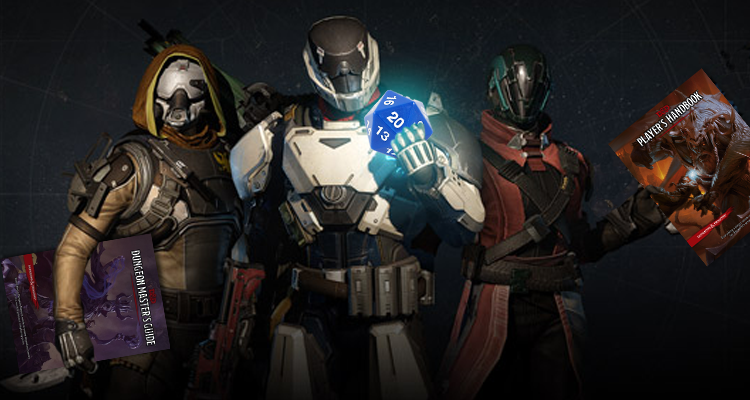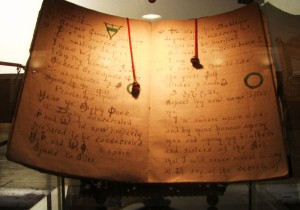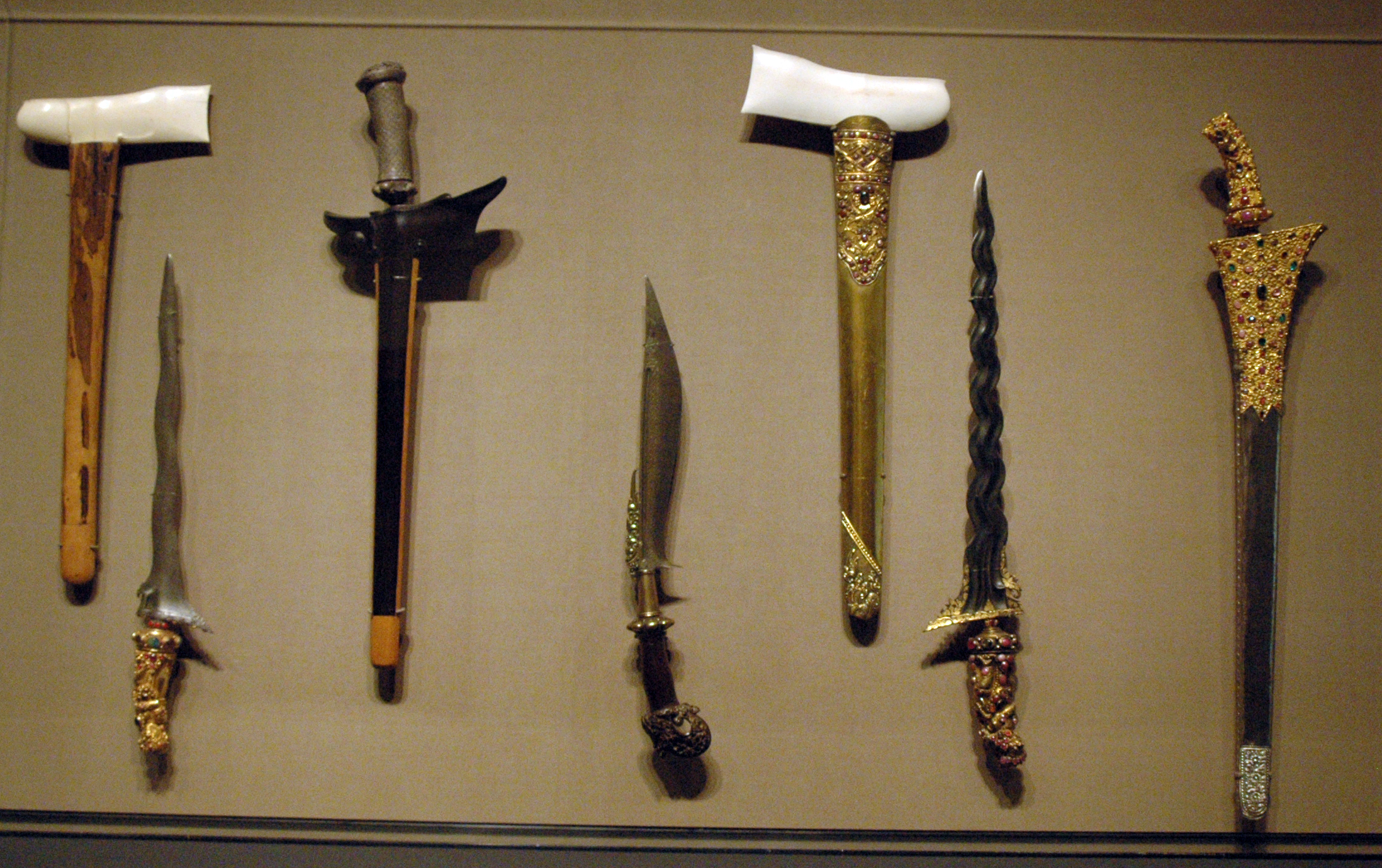After a five-month hiatus, I’ve been hitting Destiny again, and hitting it hard. With two new DLC expansions since launch, I’ve had a lot of catching up to do. With a massive new expansion scheduled for this fall, it looks like this won’t be the last time I pick this game up.
As I’ve mentioned in previous posts, my RPGs are heavily inspired by the video games I play. Despite being a sci-fi shooter, Destiny is no exception when it comes to inspiration. After all, Destiny was planned as a fantasy game, and anyone who plays it can attest to it’s numerous and prevalent fantasy themes.
All You Need is Lore
Video games have mostly linear stories in which the player is railroaded through a predetermined storyline. Destiny does have a progressive mission-based story line, but the story isn’t Destiny’s strength by a long shot, and it isn’t supposed to be. Destiny is a video game -not a novel or movie- and it rightfully wears this status with its super polished game mechanics that feel good to play.
Tabletop RPGs should be the same way. Players shouldn’t be railroaded through a story that the game master wants to tell. It’s a game! It’s meant first and foremost to be interactive. The less interactive it is, the more linear it becomes.
Leave the story telling for the table on game night.
That being said, it’s perfectly okay to strike a balance between interactivity and railroading in a story. Most adventure modules released for D&D 5e have this balance; they are meant to tell a story, but still leave room for players to interact with the world as they see fit. After all, an overarching storyline is essential to keeping the adventure cohesive. For myself as a game master, I prefer to take the Destiny route: spend more time and energy on lore, and less on creating a story that I think is interesting.
Lore offers a few benefits over a storyline. The first benefit is easier improvisation. Improvisation is an essential skill for a game master, as players are wildly unpredictable. It’s what makes those epic D&D stories that are talked about for years after they happen! It’s also an important skill for players to hone, because they’re roleplaying after all; and the better their improvisation is, the faster and more fluid their roleplaying will be.
There are a lot of great exercises to improve your improv, but when it comes to improvising for tabletop RPGs, I think the best way is to have a good handle on the game world’s lore. As a game master, when it comes to creating NPCs, towns, items, enemies, or quests on the fly, no tool is more useful than a clear and vivid vision of the game world. That kind of vision is only possible with a deep understanding of the world’s history, cosmology, and major figures.
Also, the best characters I’ve ever made came from having crystal clear visions of said characters. For these, I created intricate backstories, and worked with the GM to ensure that they fit with the world’s lore in a meaningful way. I would even go so far as to invent new factions that my character’s families or close friends belonged to. I would ask the GM if I could help develop the history of the race I played, which also helped to shape the current state of racial tension or acceptance in my GM’s world. I made those characters into real people with real motives and desires that my GM could understand, because they were rooted in the lore that the GM and I had shaped.
If the GM’s narrative ends up railroading the players, they won’t have these open opportunities for creativity. When building a campaign, don’t start with the story. Take a page from Destiny’s book of Grimoire cards, and create an extensive library of lore –everything from towns, to constellations, to factions, to enemies, to equipment. Leave the storytelling for the table on game night.
Gear Should Level Up
As I mentioned earlier, Destiny has released two expansions (at the time of this article). With three weapon slots and four armor slots, there’s a lot of room for new gear. However, some of the gear from the vanilla game is iconic. The new items are cool, no doubt, but I just can’t let go of my good old Gjallarhorn rocket launcher.
Luckily, I don’t have to! Included in the DLCs are ways to upgrade your favorite old gear so that it can compete with the newer acquisitions. There is a catch of course: the upgrade materials are often just as rare as the new items themselves. This creates an arms race to upgrade the amazing gear you already have while grabbing new goodies along the way.
Give players materials to upgrade their current weapons instead of rolling for random magical drops
Leveling up is a staple mechanic in RPGs, and applying that to equipment is a no-brainer. Take note of how your players use their characters and their equipment. If it seems like they have an item or weapon that they absolutely love, consider giving them an upgraded version, or a means to upgrade it, instead of having them roll for a new item drop.
Destiny takes weapon upgrades to the next level with perks. Perks are add-ons that enhance or customize the stats and attributes of weapons and armor. As items are used, they gain experience points that unlock upgrades and perks, for a price. Sometimes these perks can drastically change the usefulness and power of the item. Take the aforementioned Gjhallahorn, for example. It’s a relatively generic rocket launcher when first acquired, but once the Wolfpack rounds are unlocked, it becomes a weapon of an entirely different magnitude.
The upgrades don’t have to be damage based. One of my favorite weapons in the game -the “Murmur” fusion rifle- has perks that let you change its damage type on the fly. It also has one that makes it lightweight, which increases your character’s agility. These don’t directly influence the amount of damage done, but are still great utility perks.
Designing weapon and armor perks in an RPG can be a daunting task. A lot of trial and error will happen before the perk is well-balanced. The best way to start designing is to take the properties of a top-tier magical item, and turn those properties into incremental upgrades for a lower tier item. For example, in D&D, I’d take the Vorpal Sword, which is a +3 item, and divide its properties into separate “perks” that can be unlocked from a basic +1 sword. Divide the cost of the weapon by the number of unlockable perks, and you’ll have a good base value for the cost of each perk. By the end of the upgrade process, the weapon should have the qualities of the +3 Vorpal Sword and cost about the same in materials.
Designing items like this can be very time-consuming, which is why you should only do it for items you know your players love.
People, Places, and Things Should Be Characters
As I mentioned above, Destiny has a lot of lore. This lore is unlocked via Grimoire cards, and each card is unique. Some cards have bits of narrative while others are journal entries from important historical figures. Some cards have log entries from A.I. constructs, and others are vague dreamlike sequences that beg more questions than the answers they offer.
The key to making these bits of lore stand out is that each piece of major lore is treated like its own character. Every location has its own history, but only certain locations -like the Black Garden– are treated like something the players can interact with. Because of the distinct and cryptic lore of the Black Garden’s Grimoire card, it becomes more than just a place for players to fight a boss battle. It’s a living and breathing entity that forces players to consider the most profound questions in Destiny’s narrative: what are you, where did you come from, and whose side are you really on?
Give each faction, important location, and legendary item its own lore and history
Speaking of sides, Destiny has a lot of different factions despite being a story about good versus evil. Similar to D&D’s Good vs Evil and Order vs Chaos dynamics, Destiny also has multiple organizations that have a mutual goal, but have fundamental differences in how to achieve it. The Future War Cult fights against the Darkness alongside the Dead Orbit faction. Dead Orbit fights to defend humanity, and they do so with the intention of gathering enough technology to be able to leave the planetary system as soon as possible, lest all of life be consumed by the Darkness. Meanwhile, the Future War Cult insists that escape is futile, and that a final battle with the Darkness is inevitable. For them, the only plausible course of action is to prepare for the battle that will determine the fate of all of humanity.
As a player, you can sport the banners of these factions in battle, and earn reputation, giving you rewards and access to exclusive equipment. The lore sets up these factions like characters; entities with their own motives and philosophies. The mechanics then allow the characters to interact with the faction in a way that benefits them.
Enemy factions are equally as interesting, if not more so. The Fallen are a sad story of a once prosperous people whose atmosphere was destroyed, forcing them into a reality of cut-throat space piracy and a brutal social class system based on rations of their artificial atmospheric gas. The Hive defy natural laws with their ability to corrupt and deform other life forms. They use technology so mysterious it’s commonly labeled magical. The Vex can only be described as an incomprehensible force of nature with robot-like physical forms, access to space-time travel, and the intention of altering reality so that they themselves are written into the very laws of the universe.
Each faction, important location, and legendary item has its own lore and history, making them like characters that change throughout the game. I’ve used this personification tactic in my tabletop RPGs for when I want a specific item, character, or location to stand out. Decide what the conflicts of your game world will be, then decide where your world-objects -including your players and characters- fit in with that conflict.
Bungie has a 10-year plan for the Destiny franchise, so I suspect that these won’t be the only things I pick up from the game. What are some aspects of your favorite games that you’ve incorporated into your RPGs? Let us know in the comments.




